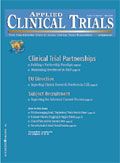Early Studies Aim to Spur Development
Applied Clinical Trials
FDA seeks to reduce clinical research failures and make drug labeling more useful.
As part of its campaign to streamline the drug development process, the Food and Drug Administration is encouraging sponsors to conduct simpler, safer, and less costly exploratory clinical trials before launching traditional Phase I studies. Its Exploratory IND (investigational new drug) policy allows researchers to examine whether very low doses of a candidate drug has a pharmacologic effect before investing in the full battery of preclinical in vitro and animal testing required for usual safety studies. By quickly examining a large number of candidate compounds, scientists will be able to cull out those that show promise and merit further testing in more science-based trials.

Jill Wechsler
FDA also seeks to better inform physicians and patients about the safe and appropriate use of prescription drugs by overhauling the format and content of approved drug labeling to make it more accessible [see sidebar]. The agency published a long-awaited final rule on labeling for drugs and biologics in January that adds a controversial "highlights" section to prominently display the most important prescribing information. All labels now will present clinical trial results and toxicology information, among other additions and revisions.

More Useful Prescribing Information
Low-dose options
By identifying promising drug candidates more quickly and efficiently, FDA's early-into-man initiative aims to speed up pharmaceutical R&D, reduce research costs, and avoid unnecessary and possibly toxic testing in both animals and humans. Nine out of ten compounds fail in human studies, reported FDA Acting Commissioner Andrew von Eschenbach in announcing the new policy in January. FDA aims to reduce this high failure rate as a prominent part of its Critical Path Initiative.
The Exploratory IND guidance [available at www.fda.gov/cder/guidance/7086fnl.htm] describes the process for conducting early trials: Administer very low doses of a drug to very few individuals (less than 20) for a short period of time (under seven days) in studies intended to have no therapeutic or diagnostic benefits for the participant. Such trials may test very low microdoses (less than 1/100th of the dose calculated to yield a pharmacologic effect) or slightly higher doses that do not produce a pharmacologic or toxic effect in the participant. Single-dose studies may collect pharmacokinetic information or perform imaging studies, while short, multiple-dose trials may test pharmacologic endpoints.
Even with such low doses, researchers will be able to use modern imaging technology and analytical methods to detect whether a test substance hits a target organ or metabolizes in a certain way. Traditional Phase I studies, explained FDA Deputy Director Janet Woodcock, escalate doses for trial participants until they reach a toxic level, but usually provide information only on what dose patients can tolerate.
Less up-front data
Sponsors of exploratory studies still have to file an IND with FDA, but this may be modified. Early study INDs may briefly describe the research program and anticipated outcomes, including a rationale for selecting the test compound and for adopting a certain study plan. Chemistry, manufacturing, and controls (CMC) information can be presented as a summary report that describes the product's characteristics, source, therapeutic class, dosage form, route of administration, formulation, method of preparation, manufacturer, and composition. A certain amount of analytical testing should demonstrate the identity, structure, purity, and potency of the candidate product. And preclinical animal testing may involve only toxicology studies in one species. FDA always will require some animal study data, Woodcock noted, but this policy creates opportunities to spare animals from testing.
To make early trials even easier, FDA also issued a new rule that permits sponsors to produce Phase I clinical supplies without complying with good manufacturing practice (GMP) requirements. The GMP exemption applies to all Phase I studies, except those that involve an already approved product, and it does not apply to drug production for Phase II or III trials. This modification of GMP requirements is "incredibly important," says Woodcock, because it will allow researchers in labs to produce small quantities of a test product without adopting policies for large-scale commercial manufacturing. Industry sponsors may continue to produce clinical supplies in GMP-compliant facilities, but this modification may help move products from the lab to the clinic, which would overcome a major bottleneck in drug development.
Cancer researchers are particularly enthusiastic about FDA's modification of GMP requirements and the exploratory study option, which National Cancer Institute (NCI) officials helped develop. Up until now, pointed out NCI Chief of Surgery Steven Rosenberg, NCI scientists who wanted to test a promising compound in human trials had to find a company with GMP-compliant facilities to produce it.
The GMP exemption goes into effect this spring if no one objects to it. If, however, a third party files "significant adverse comments," FDA will have to launch a notice-and-comment process to make this change, which could take months, if not years.
Even with the GMP exemption, researchers still must establish systems and maintain records to ensure the quality and safety of test products. A companion draft guidance to the GMP rule [www.fda.gov/cder/guidance/6164dft.htm] advises sponsors to keep complete records of production processes, including equipment maintenance, analytical tests, distribution, reagents, and components. It also offers recommendations for preventing the contamination of investigational biologics and sterile products.
Reduced exposure
If an exploratory low-dose study shows promising results, sponsors have to start all over. Before launching conventional Phase I studies, researchers will have to conduct additional animal and in vitro testing and file a new IND. At this point, though, scientists should be moving forward only with those products that appear most likely to have a positive effect on human health.
Although some skeptics regard the new policy as merely a way for drug companies to cut costs while creating additional risks for patients, Woodcock maintains that this approach will save people from being exposed unnecessarily to higher and more risky doses. Von Eschenbach emphasized that the new policy does not compromise standards for clinical trials or laboratory testing, but offers a way to use modern diagnostic tools to gain more insight. Instead of changing FDA's rules, Woodcock noted that the new policy advises researchers on "how they can take advantage of the inherent flexibility in the current regulation."
Jill Wechsler is the Washington editor of Applied Clinical Trials, (301) 656-4634 jwechsler@advanstar.com

FDA Fast Tracks Johnson & Johnson’s Nipocalimab for Fetal Neonatal Alloimmune Thrombocytopenia
March 27th 2024Johnson & Johnson is moving forward with a pair of Phase III trials of nipocalimab to reduce the risk of fetal neonatal alloimmune thrombocytopenia in alloimmunized pregnant patients.